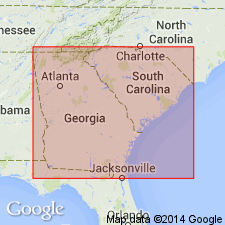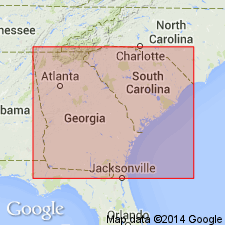
- Usage in publication:
-
- Orangeburg District bed
- Modifications:
-
- First used
- Dominant lithology:
-
- Clay
- Sand
- Coquina
- AAPG geologic province:
-
- Atlantic Coast basin
Summary:
Recent excavations in Orangeburg, SC, revealed a two-part division of the upper McBean Formation: a lower part containing PTEROPSELLA LAPIDOSA bearing carbonates and clays typical of the formation, and an upper part, here informally named the Orangeburg District bed, containing sandy montmorillonitic clays and clayey sands with thin lenticular coquinas of silicified shells. Name is based on Conrad's (1848) original locality citation for fossils of this unit. Bed underlies nonfossiliferous sands of the Barnwell Group and includes 169 molluscan species and subspecies, 58 of which are known only from the Orangeburg area. 47 occur in both the Gosport Sand and the Cook Mountain Formation and/or older formations; 44 occur in the Cook Mountain and/or older formations; and 20 occur in the Gosport Sand and/or younger Jackson Group. Unit may be of intermediate age between the Cook Mountain and Gosport formations, but authors believe that it is an Atlantic Coastal Plain equivalent of the Gosport Sand. Inclusion of the Orangeburg District bed in the upper unit of the McBean changes Cooke and MacNeil's (1952) revision of the formation that included only the Cook Mountain equivalent, the OSTREA SELLAEFORMIS zone of the Lisbon Formation.
Source: GNU records (USGS DDS-6; Reston GNULEX).

- Usage in publication:
-
- Orangeburg District bed
- Modifications:
-
- Overview
- AAPG geologic province:
-
- Atlantic Coast basin
Summary:
It is evident that the fossiliferous strata informally named the Orangeburg District bed (this volume) are the same strata that Sloan (1908) described in detail as "Barnwell phase" at Tinker Creek, Poosers Hill and Caw Caw Swamp. The Barnwell phase is now recognized as equivalent to the Claibornian Gosport Sand. Veatch and Stephenson (1911) incorrectly applied the term Barnwell to beds of Jacksonian age. Authors suggest a re-evaluation of the Clinchfield Formation, which Huddlestun and Hetrick (1986) included as the basal unit of their upper Eocene (Jacksonian) Barnwell Group in GA. Authors of this report believe that most of the Clinchfield of GA is equivalent to the Claibornian Orangeburg District bed.
Source: GNU records (USGS DDS-6; Reston GNULEX).
For more information, please contact Nancy Stamm, Geologic Names Committee Secretary.
Asterisk (*) indicates published by U.S. Geological Survey authors.
"No current usage" (†) implies that a name has been abandoned or has fallen into disuse. Former usage and, if known, replacement name given in parentheses ( ).
Slash (/) indicates name conflicts with nomenclatural guidelines (CSN, 1933; ACSN, 1961, 1970; NACSN, 1983, 2005, 2021). May be explained within brackets ([ ]).

